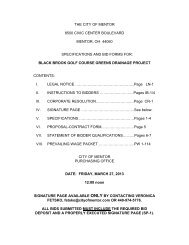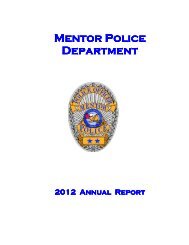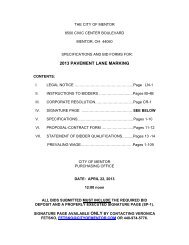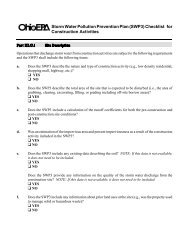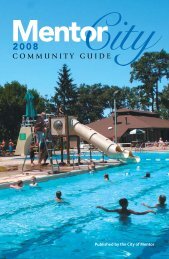Don't Mow in the Riparian Zone - Chagrin River Watershed Partners
Don't Mow in the Riparian Zone - Chagrin River Watershed Partners
Don't Mow in the Riparian Zone - Chagrin River Watershed Partners
You also want an ePaper? Increase the reach of your titles
YUMPU automatically turns print PDFs into web optimized ePapers that Google loves.
$<br />
three <strong>in</strong> a series of six fact sheets on stream management<br />
A stream’s riparian zone<br />
is <strong>the</strong> strip of natural vegetation<br />
along <strong>the</strong> banks that separates<br />
<strong>the</strong> stream from developed<br />
areas (lawns, build<strong>in</strong>gs,<br />
driveways, etc.).<br />
<strong>Mow</strong><strong>in</strong>g right to <strong>the</strong> stream edge may look neat, but<br />
it’s actually creat<strong>in</strong>g disaster, faster! You may be able<br />
to get away with it for awhile, but it will catch up with<br />
you. If you elim<strong>in</strong>ate natural plants and shrubs along<br />
a stream you lose <strong>the</strong> valuable root systems that hold<br />
<strong>the</strong> stream bank soil <strong>in</strong> place. The result: <strong>the</strong> banks<br />
erode faster, <strong>the</strong>y de-stabilize, <strong>the</strong>y crumble and<br />
cave-<strong>in</strong>, and you’ll soon be liv<strong>in</strong>g with this! Just th<strong>in</strong>k<br />
of all that valuable land wash<strong>in</strong>g away.<br />
$<br />
$ $<br />
CUYAHOGA SOIL & WATER CONSERVATION DISTRICT<br />
Project funded <strong>in</strong> part by <strong>the</strong> Great Lakes Bas<strong>in</strong> Program, Great Lakes Commission.<br />
Orig<strong>in</strong>ally written and designed by <strong>the</strong> Cuyahoga Soil and Water Conservation District<br />
<strong>in</strong> collaboration with Summit Soil and Water Conversation District and Cuyahoga<br />
<strong>River</strong> Remedial Action Plan.<br />
Don’t <strong>Mow</strong><br />
<strong>in</strong> <strong>the</strong> <strong>Riparian</strong> <strong>Zone</strong>!<br />
Water can move mounta<strong>in</strong>s! Consider<br />
that <strong>the</strong> Appalachian mounta<strong>in</strong>s were<br />
once higher than <strong>the</strong> Rockies!<br />
Ma<strong>in</strong>ta<strong>in</strong><strong>in</strong>g healthy vegetation along<br />
your section of <strong>the</strong> stream is <strong>in</strong>surance,<br />
protect<strong>in</strong>g you from changes <strong>in</strong> <strong>the</strong><br />
watershed upstream of your property.<br />
Simple Solutions<br />
Keep your stream side areas<br />
“mower-free”!<br />
If your riparian zone is<br />
healthy...MAINTAIN IT!<br />
If your riparian zone is<br />
degrad<strong>in</strong>g...IMPROVE IT!<br />
How big should a healthy<br />
riparian zone be?<br />
Ideally, a healthy riparian zone should<br />
be large enough to accommodate a<br />
naturally meander<strong>in</strong>g stream for many<br />
years to come, regardless of upstream<br />
changes <strong>in</strong> <strong>the</strong> watershed. Streams tend<br />
to meander with<strong>in</strong> a predictable width,<br />
known as <strong>the</strong>ir “belt width”. The size<br />
of <strong>the</strong> belt width is related to <strong>the</strong><br />
size of <strong>the</strong> watershed dra<strong>in</strong><strong>in</strong>g to<br />
your stream.<br />
ODNR<br />
Unfortunately, <strong>in</strong> urban areas <strong>the</strong>se<br />
recommended riparian zone widths<br />
often exceed <strong>the</strong> entire width of our<br />
properties! One rule of thumb<br />
that is often used <strong>in</strong> identify<strong>in</strong>g a<br />
recommended riparian zone width is<br />
3 times <strong>the</strong> width of your stream.<br />
O<strong>the</strong>rwise, <strong>the</strong> follow<strong>in</strong>g guidel<strong>in</strong>es<br />
are helpful:<br />
For exist<strong>in</strong>g urban backyards, a 10<br />
to 25-foot riparian zone is essential.<br />
For mid-sized streams <strong>in</strong> larger<br />
backyards, a m<strong>in</strong>imum riparian zone<br />
of 75 feet is recommended.<br />
For very large streams, a 150 to<br />
300-foot riparian zone is not only ideal,<br />
it’s smart!<br />
Want to f<strong>in</strong>d <strong>the</strong> ideal width for your<br />
riparian zone? Contact your local Soil<br />
and Water Conservation District or<br />
Chagr<strong>in</strong> <strong>River</strong> <strong>Watershed</strong> <strong>Partners</strong><br />
(CRWP) for <strong>in</strong>formation on determ<strong>in</strong><strong>in</strong>g<br />
<strong>the</strong> belt width of your stream. Many<br />
communities are adopt<strong>in</strong>g riparian<br />
setbacks <strong>in</strong>to <strong>the</strong>ir zon<strong>in</strong>g codes to<br />
protect <strong>the</strong>ir residents and ma<strong>in</strong>ta<strong>in</strong> <strong>the</strong><br />
streams natural flood control, erosion<br />
control, and water quality functions.<br />
<strong>Riparian</strong> setbacks are similar to front,<br />
side or rear yard setback which limit<br />
build<strong>in</strong>g <strong>in</strong> <strong>the</strong>se areas. Contact your<br />
locality or CRWP to determ<strong>in</strong>e if similar<br />
legislation has been adopted <strong>in</strong> your area.<br />
What Healthy <strong>Riparian</strong><br />
<strong>Zone</strong>s Do:<br />
Stabilize stream banks<br />
Provide active floodpla<strong>in</strong>s<br />
Reduce erosion<br />
Reduce sediment and chemicals<br />
from ra<strong>in</strong>water runoff<br />
Provide shade to keep <strong>the</strong> stream<br />
at cooler temperatures for healthy<br />
aquatic communities<br />
Provide wildlife habitat<br />
Increase beauty<br />
Increase property value
Supplemental Shelter for Wildlife<br />
Bats are <strong>the</strong> s<strong>in</strong>gle most important controller<br />
of night-fly<strong>in</strong>g <strong>in</strong>sects, <strong>in</strong>clud<strong>in</strong>g mosquitoes,<br />
moths and beetles. One little brown bat<br />
can eat more than 600 mosquitoes <strong>in</strong> an<br />
hour! A bat house provides critical roost<strong>in</strong>g<br />
habitat. Bat houses should be <strong>in</strong>stalled on<br />
a pole at least 15 feet high <strong>in</strong> a spot that<br />
receives sun at least 4 to 6 hours a day.<br />
Trees are generally not a good location for<br />
bat boxes due to lack of sunlight.<br />
Don’t <strong>Mow</strong><br />
<strong>in</strong> <strong>the</strong> <strong>Riparian</strong> <strong>Zone</strong>!<br />
Make or buy birdhouses that will attract <strong>the</strong><br />
type of birds you want <strong>in</strong> your yard. The<br />
size of <strong>the</strong> entrance hole is critical for<br />
successful nest<strong>in</strong>g. O<strong>the</strong>r considerations<br />
<strong>in</strong>clude box size, height above <strong>the</strong> ground,<br />
direction <strong>the</strong> entrance hole faces, and<br />
amount of sunlight. Also, make sure your<br />
birdhouses can be easily opened and<br />
cleaned annually with a mild bleach solution<br />
to reduce <strong>the</strong> spread of bird diseases.<br />
Birdhouses may need baffles to<br />
limit access by cats and o<strong>the</strong>r predators.<br />
For more <strong>in</strong>formation about birdhouses and wildlife habitat,<br />
contact your local Soil and Water Conservation District,<br />
or check out your local library. Also, search <strong>the</strong> web for<br />
<strong>the</strong> USDA Natural Resources Conservation Service<br />
Backyard Conservation Program.<br />
three <strong>in</strong> a series of six fact sheets on stream management<br />
(440) 975-3870<br />
Chagr<strong>in</strong> <strong>River</strong> <strong>Watershed</strong> <strong>Partners</strong>, Inc.<br />
P.O. Box 229<br />
Willoughby, Ohio 44096-0229



